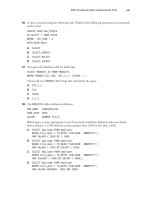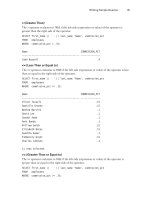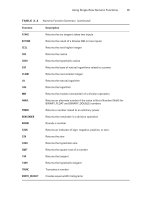OCA Oracle Database 11g SQL Fundamentals I Exam Guide P2
Bạn đang xem bản rút gọn của tài liệu. Xem và tải ngay bản đầy đủ của tài liệu tại đây (409.03 KB, 10 trang )
14
Chapter 1: Oracle Server Technologies and the Relational Paradigm
The relational paradigm is highly efficient in many respects for many types of
data, but it is not appropriate for all applications. As a general rule, a relational
analysis should be the first approach taken when modeling a system. Only if it proves
inappropriate should one resort to nonrelational structures. Applications where the
relational model has proven highly effective include virtually all Online Transaction
Processing (OLTP) systems and Decision Support Systems (DSS). The relational
paradigm can be demanding in its hardware requirements and in the skill needed
to develop applications around it, but if the data fits, it has proved to be the most
versatile model. There can be, for example, problems caused by the need to maintain
the indexes that maintain the links between tables and the space requirements of
maintaining multiple copies of the indexed data in the indexes themselves and in
the tables in which the columns reside. Nonetheless, relational design is in most
circumstances the optimal model.
A number of software publishers have produced database management systems
that conform (with varying degrees of accuracy) to the relational paradigm; Oracle
is only one. IBM was perhaps the first company to commit major resources to it,
but their product (which later developed into DB2) was not ported to non-IBM
platforms for many years. Microsoft’s SQL Server is another relational database that
has been limited by the platforms on which it runs. Oracle databases, by contrast,
have always been ported to every major platform from the first release. It may be this
that gave Oracle the edge in the RDBMS market place.
A note on terminology: confusion can arise when discussing relational databases
with people used to working with Microsoft products. SQL is a language and SQL
Server is a database, but in the Microsoft world, the term SQL is often used to refer
to either.
Data Normalization
The process of modeling data into relational tables is known as normalization and
can be studied at university level for years. There are commonly said to be three
levels of normalization: the first, second, and third normal forms. There are higher
levels of normalization: fourth and fifth normal forms are well defined, but any
normal data analyst (and certainly any normal human being) will not need to be
concerned with them. It is possible for a SQL application to address un-normalized
data, but this will usually be inefficient as that is not what the language is designed
to do. In most cases, data stored in a relational database and accessed with SQL
should be normalized to the third normal form.
Understand Relational Structures
15
There are often several possible normalized models for an application. It
is important to use the most appropriate—if the systems analyst gets this
wrong, the implications can be serious for performance, storage needs, and
development effort.
As an example of normalization, consider an un-normalized table called BOOKS
that stores details of books, authors, and publishers, using the ISBN number as the
primary key. A primary key is the one attribute (or attributes) that can uniquely
identify a record. These are two entries:
ISBN Title Authors Publisher
12345 Oracle 11g OCP SQL
Fundamentals 1 Exam Guide
John Watson,
Roopesh Ramklass
McGraw-Hill, Spear
Street, San Francisco,
CA 94105
67890 Oracle 11g New Features
Exam Guide
Sam Alapati McGraw-Hill, Spear
Street, San Francisco,
CA 94105
Storing the data in this table gives rise to several anomalies. First, here is the
insertion anomaly: it is impossible to enter details of authors who are not yet
SCENARIO & SOLUTION
Your organization is designing a new
application. Who should be involved?
Everyone! The project team must involve business analysts
(who model the business processes), systems analysts
(who model the data), system designers (who decide how
to implement the models), developers (you), database
administrators, system administrators, and (most importantly)
end users.
It is possible that relational structures may
not be suitable for a particular application.
How can this be determined, and what
should be done next? Can Oracle help?
Attempt to normalize the data into two-dimensional tables,
linked with one-to-many relationships. If this really cannot be
done, consider other paradigms. Oracle may well be able to help.
For instance, maps and other geographical data really don’t work
relationally. Neither does text data (such as word processing
documents). But the Spatial and Text database options can be
used for these purposes. There is also the possibility of using
user-defined objects to store nontabular data.
16
Chapter 1: Oracle Server Technologies and the Relational Paradigm
published, because there will be no ISBN number under which to store them.
Second, a book cannot be deleted without losing the details of the publisher: a
deletion anomaly. Third, if a publisher’s address changes, it will be necessary to
update the rows for every book he has published: an update anomaly. Furthermore,
it will be very difficult to identify every book written by one author. The fact that a
book may have several authors means that the “author” field must be multivalued,
and a search will have to search all the values. Related to this is the problem of
having to restructure the table of a book that comes along with more authors than
the original design can handle. Also, the storage is very inefficient due to replication
of address details across rows, and the possibility of error as this data is repeatedly
entered is high. Normalization should solve all these issues.
The first normal form is to remove the repeating groups, in this case, the multiple
authors: pull them out into a separate table called AUTHORS. The data structures
will now look like the following.
Two rows in the BOOKS table:
ISBN TITLE PUBLISHER
12345 Oracle 11g OCP SQL Fundamentals
1 Exam Guide
McGraw-Hill, Spear Street,
San Francisco, California
67890 Oracle 11g New Features Exam Guide McGraw-Hill, Spear Street,
San Francisco, California
And three rows in the AUTHOR table:
NAME ISBN
John Watson 12345
Roopesh Ramklass 12345
Sam Alapati 67890
The one row in the BOOKS table is now linked to two rows in the AUTHORS
table. This solves the insertion anomaly (there is no reason not to insert as many
unpublished authors as necessary), the retrieval problem of identifying all the books
by one author (one can search the AUTHORS table on just one name) and the
problem of a fixed maximum number of authors for any one book (simply insert as
many or as few AUTHORS as are needed).
Understand Relational Structures
17
This is the first normal form: no repeating groups.
The second normal form removes columns from the table that are not dependent
on the primary key. In this example, that is the publisher’s address details: these
are dependent on the publisher, not the ISBN. The BOOKS table and a new
PUBLISHERS table will then look like this:
BOOKS
ISBN TITLE PUBLISHER
12345 Oracle 11g OCP SQL Fundamentals 1 Exam Guide McGraw-Hill
67890 Oracle 11g New Features Exam Guide McGraw-Hill
PUBLISHERS
PUBLISHER STREET CITY STATE
McGraw-Hill Spear Street San Francisco California
All the books published by one publisher will now point to a single record in
PUBLISHERS. This solves the problem of storing the address many times, and also
solves the consequent update anomalies and the data consistency errors caused by
inaccurate multiple entries.
Third normal form removes all columns that are interdependent. In the
PUBLISHERS table, this means the address columns: the street exists in only one
city, and the city can be in only one state; one column should do, not three. This
could be achieved by adding an address code, pointing to a separate address table:
PUBLISHERS
PUBLISHER ADDRESS CODE
McGraw-Hill 123
ADDRESSES
ADDRESS CODE STREET CITY STATE
123 Spear Street San Francisco California
18
Chapter 1: Oracle Server Technologies and the Relational Paradigm
One characteristic of normalized data that should be emphasized now is the use
of primary keys and foreign keys. A primary key is the unique identifier of a row
in a table, either one column or a concatenation of several columns (known as a
composite key). Every table should have a primary key defined. This is a requirement
of the relational paradigm. Note that the Oracle database deviates from this
standard: it is possible to define tables without a primary key—though it is usually
not a good idea, and some other RDBMSs do not permit this.
A foreign key is a column (or a concatenation of several columns) that can be
used to identify a related row in another table. A foreign key in one table will match
a primary key in another table. This is the basis of the many-to-one relationship. A
many-to-one relationship is a connection between two tables, where many rows in
one table refer to a single row in another table. This is sometimes called a parent-
child relationship: one parent can have many children. In the BOOKS example so
far, the keys are as follows:
TABLE KEYS
BOOKS Primary key: ISBN
Foreign key: Publisher
AUTHORS Primary key: Name + ISBN
Foreign key: ISBN
PUBLISHERS Primary key: Publisher
Foreign key: Address code
ADDRESSES Primary key: Address code
These keys define relationships such as that one book can have several authors.
There are various standards for documenting normalized data structures,
developed by different organizations as structured formal methods. Generally
speaking, it really doesn’t matter which method one uses as long as everyone reading
the documents understands it. Part of the documentation will always include a
listing of the attributes that make up each entity (also known as the columns that
make up each table) and an entity-relationship diagram representing graphically the
foreign to primary key connections. A widely used standard is as follows:
■
Primary key columns identified with a hash (#)
■
Foreign key columns identified with a back slash (\)
■
Mandatory columns (those that cannot be left empty) with an asterisk (*)
■
Optional columns with a lowercase “o”









